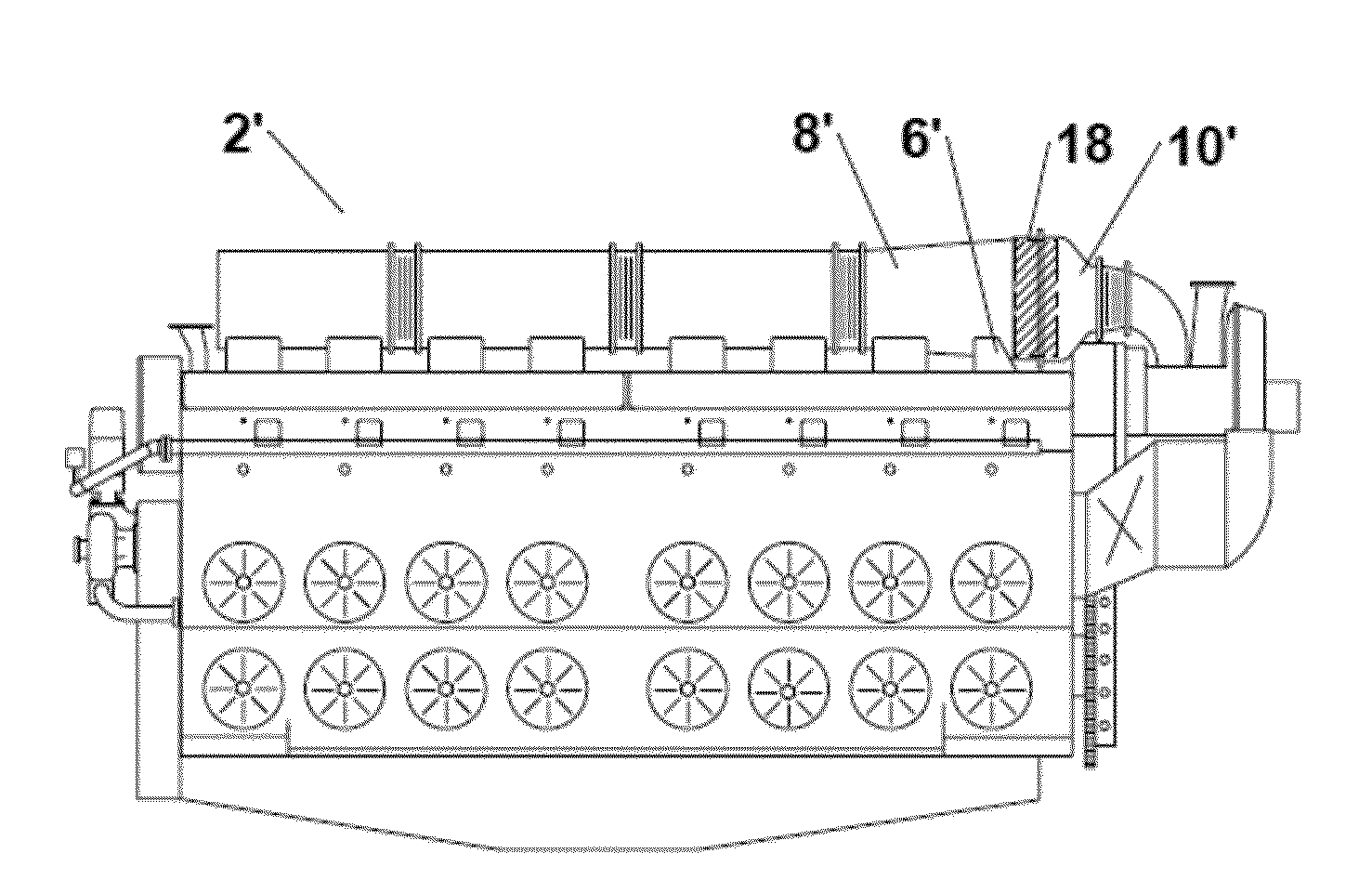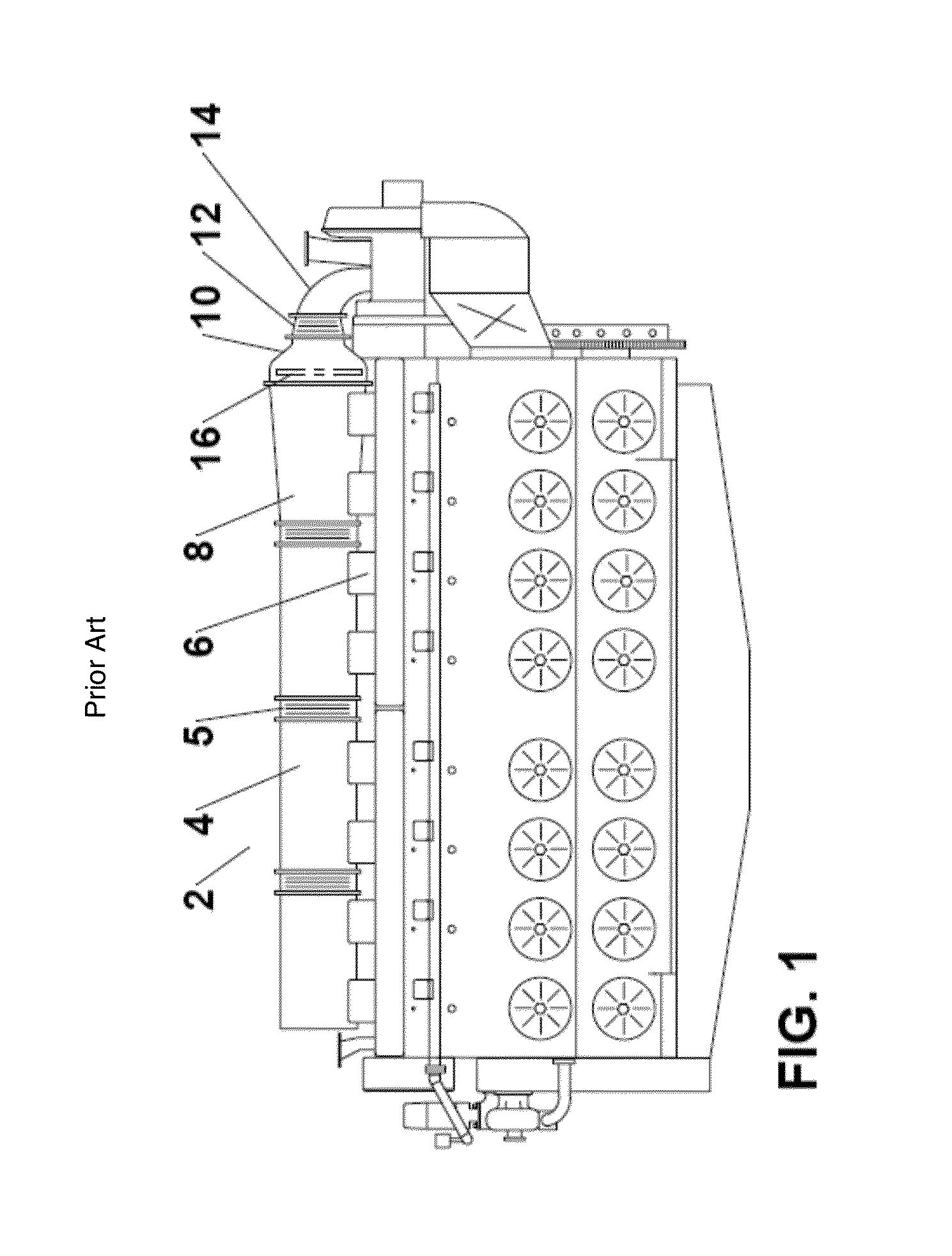This led to an actual increase of engine
thermal efficiency at some points even though the additional
back pressure of the OC would typically cause a decrease in efficiency due to reduced
airflow.
Because of the way the
exhaust manifold segments are tightly packaged across the top of the engine and there is only a short 4 inch length of common exhaust plenum before the turbo charger inlet plumbing, there was no easy way to
package a single large substrate that all of the exhaust would flow through equally.
If a single large substrate was attempted and each cylinder was affected differently, performance would suffer as some cylinders would get more intake air than others.
While accurately measured, this pressure drop is not representative of the instantaneous pressure drop that affects the
scavenging of the cylinder and how much intake air is brought into the cylinder.
Early versions of this single substrate per cylinder OC
system suffered substrate failures that were attributed to the pulsing effect of the exhaust gases flowing rapidly through the substrate for only ⅓ of the
crank rotation.
Further the
NOx reduction efficiency of the Compact SCR
system at
throttle setting of idle through Notch 2 were very low.
On the other hand the
low load reduction in SCR efficiency is because the engine
air fuel ratio is becoming too lean and the exhaust temperature is very low.
Also at these lower loads the engine actually needs less air because it is making less power and consuming less fuel.
This causes the engine to take in even more air than is needed and this excess air in the
combustion chamber lowers the exhaust temperature.
At idle this problem is at its worst as the low RPM allows a long time for
scavenging and the minimal engine fuel consumption further drives down the exhaust temperature.
If the flow is swirling in the direction of the centrifugal
impeller rotation then the amount of
pressure rise across the impellor will decrease as the impellor will not be able to put as much work or energy into the flow.
This would increase the amount of work or energy that the impellor will impart into the
airflow increasing the
pressure rise.
What this leads to is a mixing challenge where the air and fuel have limited time to mix as the
piston rises up to
top dead center right before ignition.
This mixing challenge is why SwRI on their single cylinder development EMD 710 engine decided to do premixing of the air and fuel even though it would not be practical on an ‘in service’ engine as too much unburned fuel would blow through the cylinder into the exhaust while
scavenging.
The in cylinder mixing issue can make prechamber operation difficult if a rich pocket of air and gas gets pushed into the prechamber which already has excess fuel in it.
At these very high lambdas it would require a larger prechamber that will produce fewer
NOx emissions and have a lower
thermal efficiency.
When the inlet is throttled to help reduce the
low load air fuel
Lambda, a large portion of this mixing energy is lost.
First it has many machined parts with complicated features that will be costly.
Second, the design has a built in cavity where residual
natural gas will be compressed into and remain unburned during the
combustion event.
This release of unburned
methane is both a
pollution emissions problem and an energy efficiency problem.
The cooling of a prechamber is one of the challenges, and the most challenging part of the prechamber to cool is the
nozzle or tip area.
With
insufficient cooling it has been documented that overheating prechambers will often melt the tip of the prechamber.
Sometime before the tip actually melts, it will cause preignition which will limit how much power the engine can produce or cause the engine to run improperly during some conditions.
This will cause the other cylinders to have to operate at a
higher power to make up the lost power from the deactivated cylinders.
Because the prechamber is still fed fuel, but the main chamber is not, there is no guarantee that the mixture in the prechamber is being burned when a cylinder is deactivated, even when the
spark plug is still being fired.
When the cylinder is deactivated the air pushed into the prechamber by the
piston will not have any fuel so the overall mixture in the prechamber may be too lean for the spark to burn.
Because skip fire happens at
low load it's likely that the
extended time the system gets to fill the prechamber offsets this deactivated cylinder issue, but at the same time the operating cylinders are running richer and having the deactivated cylinders prechambers rich enough to fire may make the activated prechambers too rich causing misfires or
combustion instability.
The generation of Non-
Methane HC emissions is especially problematic as after the
spark plug initiates combustion in the prechamber some unburned
natural gas is pushed out of the prechamber into the main chamber before it is burned inside the prechamber.
There are several issues that make water injection not worth the effort of implementation in most mobile applications; one is the volume and weight of the consumable water and second is the need to refill the container that would store it.
Once these issues are overcome, then there is the
environmental issue of keeping the stored onboard water from freezing when the vehicle is not in operation.
Another issue is the challenge of
corrosion to the hardware that would be used to inject it, especially if the
injector is designed to open and close rapidly for each cylinders combustion cycle.
Finally is the
corrosion issue as related to any other parts.
If after
shut down an
injector would leak water into the engine cylinder during engine storage, that cylinder will have internal
corrosion and suffer significant maintenance issues.
If it wasn't reduced the engine may be limited to only generation of 60% of its original diesel operation rated power.
 Login to View More
Login to View More  Login to View More
Login to View More 


